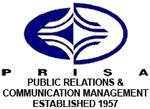
Top stories






More news

















The new guidelines are embodied with a document that provides industry guidelines for media measurement, which are tangibly linked to programme goals. Organisations around the world are demanding greater proof of the impact achieved by their public relations campaigns. While the unit known as Advertising Value Equivalent (AVE) has traditionally been used, it assumed that the media exposure in itself is the end objective of public relations. Ultimately, it is the impact of the exposure that organisations are seeking to measure.
PRISA is concerned about the trend within the industry where AVE is frequently exaggerated by using multiplier factors based on prominence, image impact, prestige of the media channel and other criterion. This results in attributing inflated and subjective values to media publicity against the comparative value of paid advertising space or airtime.
Lesley Schroeder-McLean APR noted that "AVE creates considerable confusion in how to go about calculating negative publicity or bad news which was minimised or kept out of the media entirely. The 'column per centimetre' value of negative publicity, which can be hugely damaging to an organisation's reputation, would need to be measured in a different way to news, which is positive. Negative media publicity highlights the flaws of trying to compare two separate disciplines (advertising and media publicity) designed to do different things; which begs the legitimacy of comparing them."
Public relations practitioners are increasingly required to demonstrate the extent to which PR activity supports and achieves business objectives. This requires measurement of all outputs against business objectives.
Professionalism and best practice require practitioners to introduce the most valid measurement metrics to clients and organisations so that the industry can move the focus away from output measurement to content analysis and impact on reputation, as well as correlation to bottom line performance.
Schroeder-McLean adds, "While PRISA accepts that AVE measurement is used by many practitioners - and is not advocating its exclusion - the practice of applying multiplying factors to AVE measurement is strongly discouraged. This means that if AVE is used as a measurement method, only a direct 1:1 comparison of value should be used. It is also encouraged that qualitative units of measure are added to this sole quantitative unit of measurement."
Daniel Munslow, chief communications officer at Talk2Us, added, "The PRCC engaged influencers in the communication sphere and agreed to adopt new guidelines in communication measurement that would be applicable to both traditional and new media. The new guidelines afford the industry and profession in the country to be more comparable than ever before; use the same units to measure across media types; include basic qualitative measurement units; and shift thinking from perception to reputation. This evolution brings about new rules of engagement by providing an innovative framework to the measurement landscape."
The full evaluation criteria adopted by PRISA are available on the institute's website, www.prisa.co.za, where suggested media content analysis criteria can be found. It creates an environment conducive for public relations practitioners to easily and accurately measure media exposure themselves.